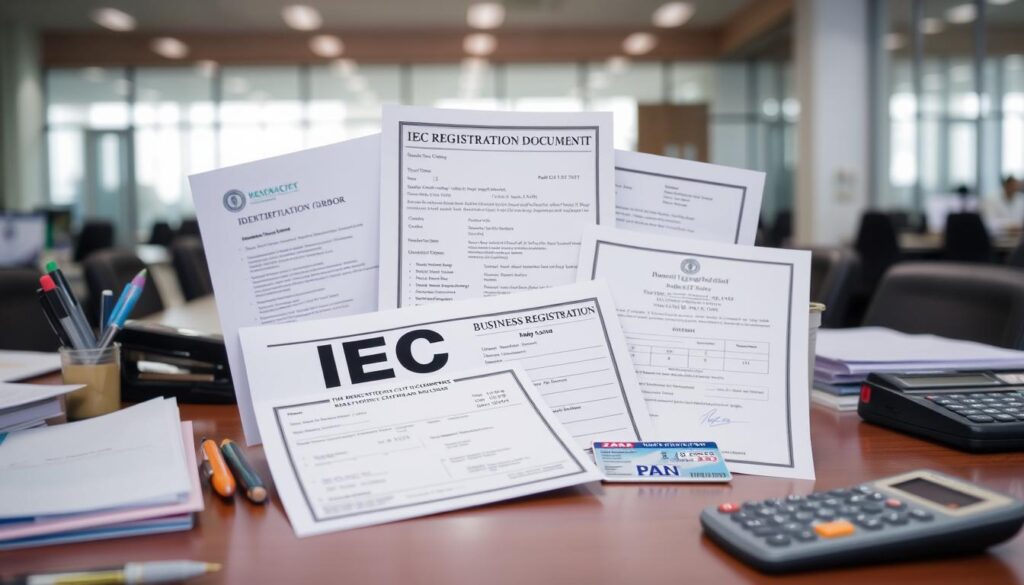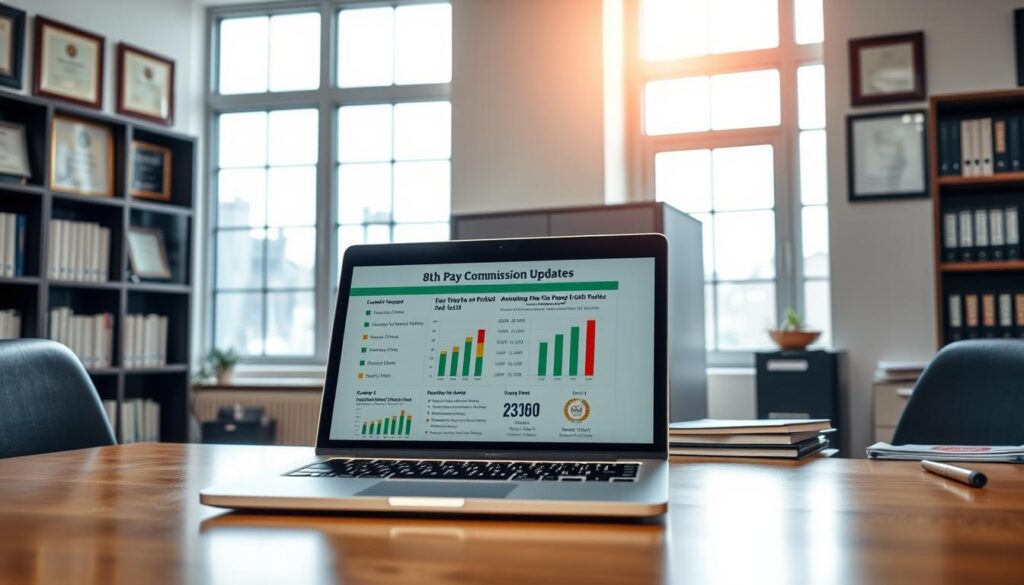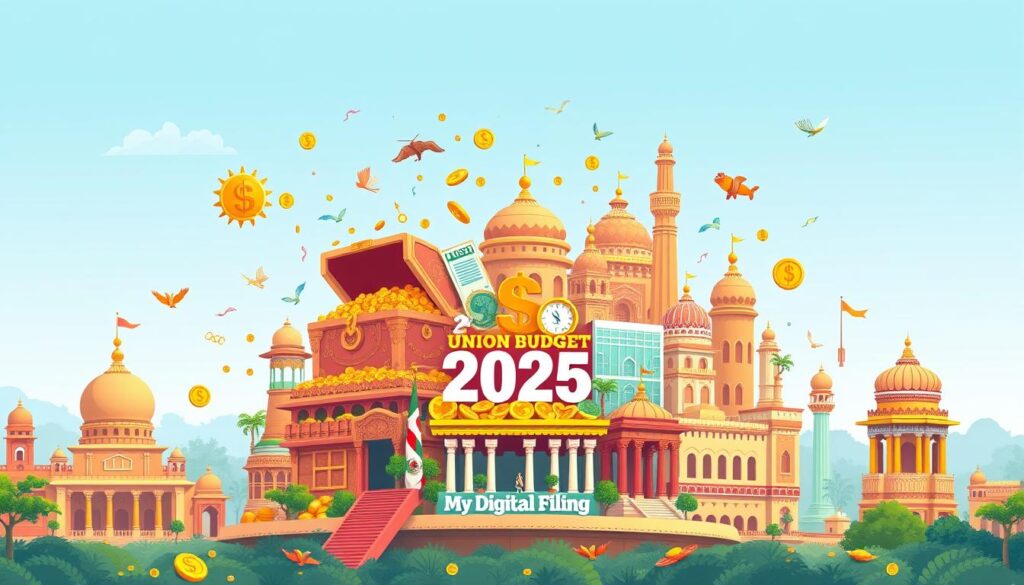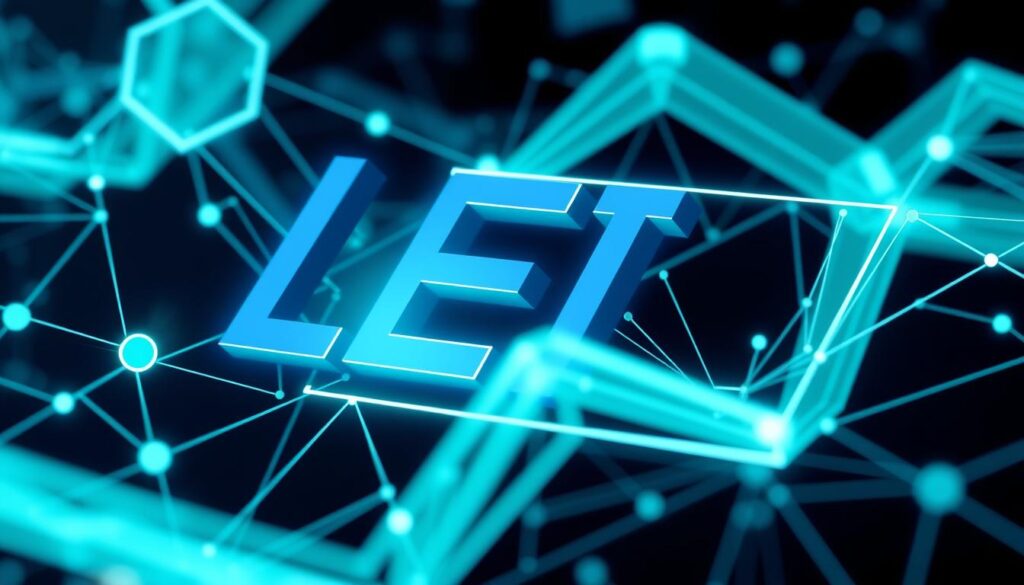India’s international trade is growing fast. How to get Import Export Code (IEC) is key for businesses wanting to trade globally. The IEC lets you do international business legally and offers many benefits.
It makes customs clearance easier and lets you get government help. But, how do you apply for an IEC with all the paperwork and rules?
For small businesses and professionals, getting an IEC online is a big step. You need to gather the right documents, like ID, address proof, bank details, and photos. You also need to know India’s Foreign Trade Policy well.
The IEC application process is not hard, but you must pay attention to details. Make sure your documents are correct and up-to-date. Avoid mistakes like incomplete applications.
With careful planning, you can get your IEC in just 1-2 weeks. This opens up many chances for your business to grow.
As you start to grow your business globally, mydigitalfiling.in will help you. We’ll make sure you follow the rules and use the IEC’s benefits fully. Stay with us to learn how to smoothly get your IEC and enter India’s trade world.
Understanding the Import Export Code (IEC)
The Import Export Code (IEC) is key in India’s trade world. It’s a 10-digit code that helps businesses trade internationally. It’s a must-have for any business looking to trade globally.
What is an Import Export Code (IEC)?
The DGFT issues the IEC, now in electronic form (e-IEC). To get one, you need a digital signature token and pay Rs. 500. The IEC stays valid forever if you update it every year.
From April to June, updates are free. This makes the IEC easy to use on many platforms.
Importance of IEC for Businesses
The importance of IEC is huge. It lets businesses trade legally worldwide. It also opens doors to government export incentives, helping them compete globally.
An IEC acts as a license for both exports and imports. It helps avoid trade risks and offers tax breaks. This makes trading easier and more profitable.
Keeping your IEC up to date is essential. You must update it between April and June each year. This keeps your business active in international trade.

| Feature | Detail |
|---|---|
| IEC Issuance Time | Within 10-15 working days (after document verification) |
| Application Fee | Rs. 500 |
| Annual Update | Mandatory between April and June; no fee charged |
| Validity | Lifetime, provided yearly updates are made |
| Accessibility | Supported by major browsers like Chrome, Firefox, IE, Safari |
Using an IEC lets businesses trade legally and globally. It helps them reach customers worldwide, showing and selling their products globally.
Eligibility Criteria for Obtaining an IEC
To trade internationally and enjoy policy benefits, businesses and individuals need an Import Export Code (IEC). The iec eligibility criteria depend on the business type. Meeting these criteria is the first step in the import export code registration online process.
- Individuals and sole proprietors need a PAN card, a bank account, and proof of business address to apply.
- Partnership firms are required to provide a partnership deed, a PAN card, and business address proof.
- Limited Liability Partnerships (LLPs) and Private Limited Companies must submit an incorporation certificate along with other basic documents.
- Public Limited Companies follow similar requirements to private limited companies.
- Other entities like Societies, Trusts, and HUFs (Hindu Undivided Families) must have a registration certificate, PAN card, and proof of address.
The DGFT’s e-governance initiative has made IEC registration easier. Now, all steps from application to documentation can be done online. This makes import export code registration online simpler.
| Business Type | Required Documents | Application Step |
|---|---|---|
| Proprietorships | PAN, Bank Certificate, Business Address Proof | Apply via DGFT Website, Upload Documents, Pay Fees, Await Verification |
| Partnership Firms | Partnership Deed, PAN, Address Proof | |
| LLPs | Incorporation Certificate, PAN, Bank Details | |
| Private/Public Ltd. | Certificate of Incorporation, PAN, Address Proof | |
| Societies/Trusts/HUF | Registration Certificate, PAN, Address Proof |
By meeting the iec eligibility criteria, entities can operate smoothly in the global market. They can use IEC benefits for customs, trade laws, and international exposure.

Documents Required for IEC Registration
Getting an Import Export Code (IEC) is key for your business to trade internationally. We’ll cover the important documents you need for IEC registration. This ensures you meet the Directorate General of Foreign Trade (DGFT) rules.
Documents for Individuals
People wanting an IEC need to collect some important documents. These are needed to check if you’re eligible:
- Proof of Identity (POI) like a PAN Card or Aadhaar Card
- Current Address Proof
- Bank Certificate as per DGFT format or Cancelled Cheque with your name and account number
- Passport-sized photographs
- Copy of Digital Signature Certificate (DSC)
Documents for Business Entities
Businesses need to provide more documents, depending on their type. This includes partnerships, proprietorships, or corporations:
| Type of Entity | Mandatory Documents |
|---|---|
| Proprietorship | PAN Card, Proof of business establishment, Bank certificate |
| Partnership | PAN Card of entity, Partnership deed, Bank certificate |
| Company | Company’s PAN Card, Incorporation Certificate, Bank certificate, Proof of address |
Every type needs passport photos of the owners or signatory. You also need a copy of the DSC. These steps help verify who you are in trade dealings.

Having the right documents makes the registration process easier. It lets businesses and individuals start or grow their international trade. Making sure these documents are correct and complete is key to getting your IEC.
Step-by-Step Guide to Apply for IEC Online
Getting an Import Export Code (IEC) is key for businesses trading internationally. Here’s a simple guide on how to get your IEC through the IEC online portal.
- Visit the DGFT Website: First, go to the Directorate General of Foreign Trade’s official website. It has the IEC online portal.
- IEC Profile Management: On the portal, choose ‘IEC Profile Management’. This part is for IEC registration and management.
- Fill the Application: Fill in all the details about your business and personal info. Make sure everything is correct to avoid problems later.
- Upload Documents: Upload the needed documents like a PAN card, Aadhaar card, and business bank details. They should be under 5MB and in JPEG or PDF format.
- Preview Application: Check your application before you submit it. Make any changes if needed.
- Submit with Digital Signature: Sign your application digitally. This makes your information official.
- Payment of Fees: Pay the registration fee online. The fee is currently Rs. 250.
By following these steps, you’ll send your application to the DGFT. It usually takes 10 to 15 days to process. If everything is correct, you’ll get your IEC electronically. With it, your business can start importing and exporting legally. This opens up many opportunities, like getting loans up to Rs. 80 lakh from places like Bajaj Finserv. The interest rates can be between 14% and 30%.
Also, remember that the IEC doesn’t need to be renewed. This means you can focus more on growing your business without worrying about paperwork.
For help during the application, the IEC online portal has lots of guidance. It makes getting your Import Export Code easy and hassle-free.
How to Get Import Export Code: The Application Process
Getting an Import Export Code (IEC) is key for Indian businesses trading globally. This 10-digit number makes international deals smooth and legal. It also meets important rules. The online application for an IEC is detailed and needs careful following of DGFT guidelines.
Filling Out the Application Form
The first step is to fill out the form on the DGFT website. You need to put in your personal and business details, like PAN, Aadhaar, and bank info. Make sure everything is correct to avoid problems.
You also have to upload digital copies of your PAN card, Aadhaar card, and photo. Your business documents, like a certificate of incorporation, are also needed.
Submitting the Application
After filling out the form and uploading documents, you need to submit it. You must sign it digitally to prove the info is real. Then, pay a fee of INR 500 online through the DGFT portal.
The DGFT will then check your application and give you the IEC. This usually takes 10-15 days. Once you get it, you can download it from the DGFT portal or get it via email.
- Ensure all personal and business details are accurate.
- Double-check the document uploads for clarity and correctness.
- Keep a record of the application reference number for tracking purposes.
By following these steps, you can get your IEC. This lets your business trade legally with other countries in India.
Processing Time and Tracking Your Application
The import export code registration process is easy and fast, usually taking 1-2 weeks. During this time, businesses can track their iec code application status. This lets them plan their trade activities without long waits.
Expected Processing Time
The time to process an IEC application can change based on how many are submitted and the details. Usually, it’s 1-2 weeks. This quick processing lets businesses start trading internationally fast.
Tracking Your IEC Application Status
Iec code application tracking is key in the import export code registration process. After applying, you get a reference number. Use this to track your application on the DGFT’s portal. This keeps the process clear and lets you know your application’s status in real-time.
- Visit the DGFT’s official website and navigate to the IEC section.
- Enter the reference number provided during the application submission.
- View the current status of the application, which can include various stages such as “Received”, “Under Processing”, “Approved”, or “Needs Amendment”.
Keeping an eye on your application helps you know what to do next. It also cuts down waiting time by fixing any problems quickly.
Receiving Your Import Export Code
After your application for the Import Export Code (IEC) is approved, you get the code. This is a big step for your trading business. The Director General of Foreign Trade (DGFT) sends the IEC mostly by email. Here’s what you need to know about getting and checking your IEC. This ensures you follow rules and use it well in international trade.
The dgft iec registration ends with the IEC being sent to you via email. The email has a link to download the document. This digital document is key for starting your import and export work. It’s important to make sure you get this code and can find it easily for future international deals.
- Store your Import Export Code securely: Once you get it, make sure to keep many copies of the IEC safe. This code is needed for customs, banking, and government tasks. Having it in different places helps avoid delays.
- Verify the details: Check that all info on the IEC is right. Mistakes can cause problems. If there are errors, ask for them to be fixed right away.
- Periodic Verification: You must check your IEC code online regularly. This keeps it valid. Not doing this, mainly between April and June, can make the code stop working.
The iec code validity is key for keeping your import and export work going smoothly. Staying on top of these checks is very important. It helps you manage your international trade well.
The IEC is not just a rule but also helps your business grow globally. Managing your IEC well lets you use its benefits while following DGFT rules.
In short, getting your IEC is the start of your global trade journey. Always check the code is correct, keep it safe, and follow the DGFT’s check-up rules. This way, you can use it to its fullest.
Benefits of Having an IEC
The Import Export Code (IEC) is more than a rule for businesses trading internationally. It opens doors to many advantages and financial perks. Knowing how the benefits of IEC boost business can help companies thrive in global markets.
Legal Requirement for International Trade
An IEC is a must for companies trading in or out of India. It’s a 10-digit code from the Directorate General of Foreign Trade. Without it, no business can trade internationally. It links to the PAN card for secure transactions.
Ease of Doing Business
IEC registration benefits make doing business easier. It cuts down on paperwork and makes following rules simpler. The code lasts forever, so businesses can focus on what they do best. Getting an IEC is quick and easy, making businesses ready for international trade fast.
Access to Government Schemes and Benefits
One big iec application benefit is getting government help for trade. This includes tax breaks and duty rebates. These perks help businesses compete and grow.
These financial aids lower costs and let businesses grow with less risk. Export Promotion Councils and Customs Authorities help IEC holders. This opens up more chances to succeed in global trade.
| IEC Registration Benefit | Description | Impact on Business |
|---|---|---|
| Legal Compliance | Ensures compliance with international trade laws. | Vital for lawful international business operations. |
| Lifetime Validity | Issued once and valid for the lifetime of the business. | Removes the need for renewal, saving time and effort. |
| Access to Government Benefits | Eligibility for tax reliefs and subsidies under trade policies. | Reduces operational costs and enhances profitability. |
| Global Market Access | Facilitates hassle-free entry into global markets. | Increases market size and sales chances. |
Using the benefits of IEC in your business plan can bring big rewards. It makes international dealings smoother and opens up financial benefits. The IEC is a key tool for businesses looking to grow globally.
Validity and Renewal of IEC
The iec code validity is key for businesses in international trade. It ensures they follow rules and makes customs processes easier. But, the Import Export Code (IEC) needs regular updates, not just once.
The IEC is a 10-digit number that doesn’t need frequent renewals. But, it must be updated every year to stay active. This keeps the IEC valid and in line with trade laws.
Here’s why an updated IEC is important:
- It helps clear goods at customs smoothly.
- It keeps businesses credible with clients and partners worldwide.
- It avoids fines and penalties for not following rules.
Every year, from April to May, IEC holders must renew their codes. Missing this time can cause the DGFT to deactivate the IEC. The renewal steps are:
- Log into the DGFT portal.
- Use a digital signature to authenticate.
- Update details like address and director changes.
- Submit the renewal application with needed documents like PAN and Aadhaar cards.
- Download the new IEC certificate after approval.
If you miss the renewal window, you can reactivate your IEC. But, this can be hard and might disrupt your international work.
Businesses should keep track of renewal dates. Make sure all documents, like PAN and ID proofs, are ready and updated. This makes the renewal process smooth.
| Document Type | Details Required |
|---|---|
| Company PAN | Scanned copy of the company’s PAN card |
| Registered Address Proof | Any government-issued document listing the company’s address |
| Directors’ PAN Cards | Scanned copies of all directors’ PAN cards |
| Aadhaar Card Copies | Scanned copies of Aadhaar cards of directors |
| GST Certificate | Copy of the current GST certificate |
The IEC renewal process is predictable. This lets businesses plan ahead and avoid disruptions. By keeping up with renewals, businesses can improve their international trading.
Common Issues and How to Resolve Them
Getting an Import Export Code (IEC) can be tricky. Knowing how to fix common problems is key to a smooth process.
Incomplete or Incorrect Application
One big reason for delays is filling out the application wrong. People often forget to fill in important parts or get their business info wrong. Here’s how to avoid these mistakes:
- Double-check all entered information for accuracy before submission.
- Ensure that all required fields in the application form are duly filled out.
- Refer to the guidelines provided on the DGFT website to understand the form requirements.
Lack of Required Documents
Another common problem is not having the right documents or not following the rules. You need things like a PAN card, proof of address, and bank details. It’s easy to forget about the format or attestation rules:
- Prepare all documents as digital copies in the required formats, such as PDF or JPEG.
- Avoid common mistakes, like submitting expired identification or incomplete bank details.
- Use the checklist on the DGFT portal to verify that all necessary documents are gathered.
For those wanting to trade internationally, solving these problems quickly is vital. Here’s a table with some tips:
| Issue | Solution |
|---|---|
| Incorrect Personal/Business Details | Review and update details via the DGFT portal before final submission. |
| Document Attestation Errors | Ensure documents are attested as per guidelines, where applicable. |
| Missing Documents | Refer to the detailed checklist on the DGFT website; prepare and attach. |
| Technical Issues during Submission | Contact DGFT helpdesk for technical support or try submitting during non-peak hours. |
Fixing these problems makes the application process easier and reduces the chance of rejection. By using these tips, you can make the IEC process smoother and open doors to international business.
Seeking Professional Assistance for IEC Registration
For businesses in international trade, getting an Import Export Code (IEC) is key. It’s not just a formality but a big step to improve operations and reach more markets. Many turn to a import export code consultant for professional IEC assistance. These consultants make sure the application goes smoothly, from start to finish.
Benefits of Engaging Compliance Services
Getting help from a professional IEC service has many advantages. It reduces the chance of mistakes that could delay or reject your application. Experts know the latest rules and make sure all documents are correct and submitted properly. They also help keep your business up to date with trade laws, avoiding legal issues.
How mydigitalfiling.in Compliance Services Can Help?
mydigitalfiling.in is known for its expert help and clear process for IEC registration. They make the complex process easier, so businesses can focus on what they do best. They check your documents, file your application, and follow up to get it approved fast. They also handle renewals and updates, keeping your IEC valid.
| Commodity Imported | Percentage | Relevance to IEC |
|---|---|---|
| Petroleum in its purest form | 21.6% | High dependency on IEC for international trading |
| Gold | 5.9% | Crucial for legal trade compliance |
| Products derived from petroleum | 5.8% | IEC required for export/import operations |
| Briquettes, coal, and coke | 4.7% | IEC facilitates regulatory clearances |
| Precious stones, including pearls | 4.7% | Essential for international trade permissions |
| Components for electronics | 3.4% | IEC aids in hassle-free customs process |
In conclusion, using a import export code consultant like mydigitalfiling.in is smart. It ensures you follow international trade rules and makes your operations better. This help makes getting an IEC easier and faster, letting businesses grow globally with confidence.
Conclusion
Getting an Import Export Code (IEC) from the Directorate General of Foreign Trade (DGFT) is the first step for your business to go global. The process of iec registration online might seem hard, but it’s key for international trade. This guide helps make the dgft iec registration easier, covering who can apply, what documents you need, and how to apply online.
The IEC, a 10-digit code, is valid for life but needs yearly updates. The cost is just Rs. 500, but mistakes or not renewing on time can cost more. So, it’s important to pay attention to the application and renew on time, from April to June.
The IEC is more than a formality; it opens doors to the world market. It helps with customs clearance, financial deals, and growing your business. By avoiding mistakes and following DGFT rules, Indian businesses can use international trade wisely. The easy online process shows India’s effort to make trade easier and help businesses reach out to the world.









